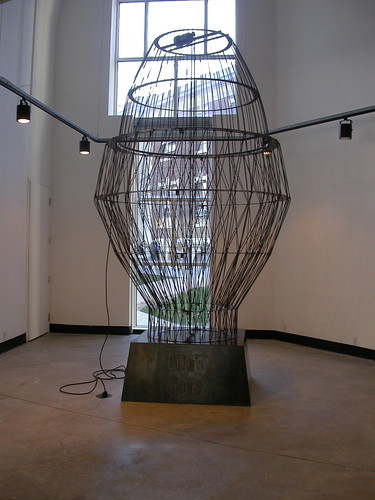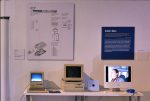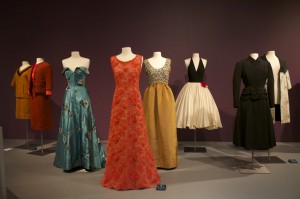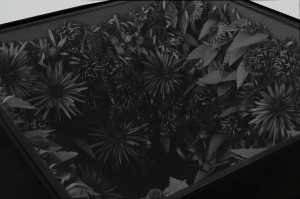
Michael Grothusen‘s welded metal structures Life’s Joys and Life’s Disappointments are as far from today’s anti-matter assemblage art as Gustave Eiffel‘s Tower was foreign to the streets around it when it debuted in 1889. Eiffel’s Tower , which took 2 years, 2 months and 5 days to complete and is composed of 18,038 pieces fastened with 2,500,000 rivets is of course a completely different animal from Grothusen’s metal sculptures. But in their monumentality and lacey industrial machismo — as well as in their ability to make you think — these pieces are kindred spirits.
Grothusen’s twin vessels (at Drexel’s Leonard Pearlstein Gallery to Dec. 12) have a look of delicacy that suggests yarn, woven threads and hair. The pieces look a little like an egg seated in an egg cup on an almost preposterously heavy base. They are neither male nor female and yet as a pair they suggest a couple. They also could be bookends or even trophies of a wry sort.
Because they look so much alike (and I’m sorry I couldn’t capture the two large objects together in one shot but it was more than my camera could do), you might think they’re identical. But, since they’re hand-made, they have individual lilts and tilts that give them subtle distinctions. They may look like twins but, like twins, they are slightly different physically and have different personalities.
They could also be one person seen at two points in life, or two people who have different orientations (glass half full, glass half empty).

Check out the welds! each stick, all the sides of the base, everything was welded.
The works have a kinetic element caused by a motor and a small chain that stretches from top to base of the open vessel form. The chain moves slowly up and down and the thrum of the two motors and the clicking of the two chains on the two metal bases evoke a quiet factory of some sort where work never ceases. There’s something reassuring about the perpetual motion and sounds, something akin to the sound of steam radiators which produce their warmth with a friendly audio accompaniment of tick, clack and tock. Although depending on your tolerance for noise, the piece might get on your nerves. I liked it.

The chain drags along the base, scraping it and sounding like a set of keys being fumbled with on a metal desk.
Grothusen, Tyler grad (1991), UArts faculty and Pew fellow, had a solo exhibit in 2001 at Gallery Joe that involved maps and geographical references. But the artist has always been all about humans and their needs and wants. He’s also always been about measurements of unmeasurable things like love, time and levels of satisfaction.
Humble and without posturing, Grothusen’s beautifully-crafted works with their dense conceptual underpinnings deal with what it means to be human.
Here’s an excerpt from a piece I wrote for the Weekly in 2001 for the artist’s Gallery Joe solo.
“I love to make things,” says Michael Grothusen, whose solo show of new work, “(Un)explained Phenomenon,” opens at Gallery Joe Oct. 20 (2001). “Sculptors should know how to make things,” he adds.
Grothusen, Tyler MFA (1991), PEW fellow (1999) and University of the Arts faculty member, is debuting several mechanized pieces–new for him–that use motors, fans and steam. The artist, who changes materials to suit his ideas and who has previously worked with wood, concrete, plaster and Home Depot materials (like pink Fiberglas insulation), sometimes worries about not having a “signature” look.
“What is a signature?” he asks rhetorically. “I guess if you wanted to say something about my work–all my work is about fragility, but it all looks solid.”
Grothusen used motors and movement for this new work, partly to address issues of time (revolutions being good visual metaphors for the passage of time) and change (water becoming steam, hinting at the instability and changeability of materials–and life). But he’s not committed to motors. Though they solved problems this time, he may be on to something else next.
A soft-spoken, intense man, Grothusen’s sentences pour out like Zen aphorisms. He’s a big thinker and speaks about concepts like “measuring the unmeasurable.”
Almost all the new pieces, flat plates made of cut steel, have the look of maps. Everything dangles at around knee level or sits low on the floor so that you feel like a giant walking among them. One piece spins clockwise and counter-clockwise, blown by a small fan. Other pieces hiss and tick as water in copper boilers heats up and steams pours out tiny holes. The visuals are a mix of the austere, the elegiac and the Franklin Institute.
But the aural experience–hissing, whirring, ticking, clacking–conveys a kind of machine-musical domestic charm, like that found in old houses with aging appliances.

Looking through Life’s Joys at Life’s Disappointments.
This show comes with a great brochure with beautiful images by John Carlano and an essay by Leah Douglas, Director of the Philly Airport’s art program. This hand-made, conceptually-loaded work should be must viewing for anyone interested in sculpture. Without being messy or loaded with pop culture references this work gets to the core of how people feel. We worry about fleeting joy, we worry about being disappointed, and depending on who we are, we’re either bitter and mad or shrug-shouldered and accepting. For truly, life comes with both joy and disappointments and it’s what you make of it all that makes you you.
More photos at flickr.










